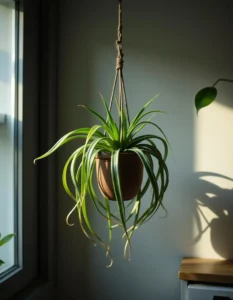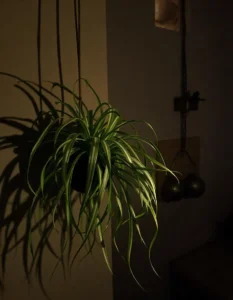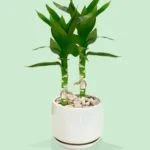Caring for Spider Plants: The Ultimate Guide to Healthier Indoor Plants
Caring for spider plants, scientifically known as Chlorophytum comosum, is a simple yet rewarding task for both novice and experienced gardeners. This low-maintenance plant, which also purifies the air, is a favorite choice for adding a touch of green to any home. Spider plants are among the easiest houseplants to care for, making them ideal whether you’re a beginner or a seasoned indoor gardener. If you’re thinking about adding one of these resilient and attractive plants to your indoor collection, caring for spider plants is both rewarding and surprisingly easy.
In this comprehensive guide, we’ll cover everything you need to know about caring for spider plants, including lighting, watering, soil preferences, fertilizing, pruning, propagation, and solving common issues. By the end of this article, you’ll have all the knowledge and tools necessary to keep your spider plant healthy and thriving.
Why caring for Spider Plants Is Ideal for Indoor Gardening
 Before diving into the details of how to care for spider plants, let’s explore why they are such popular houseplants. Spider plants have long, arching leaves that emerge from a central root system, often producing “babies” or plantlets, which resemble spiders hanging from a web—hence the name. Beyond their unique appearance, here’s why caring for spider plants is highly favored:
Before diving into the details of how to care for spider plants, let’s explore why they are such popular houseplants. Spider plants have long, arching leaves that emerge from a central root system, often producing “babies” or plantlets, which resemble spiders hanging from a web—hence the name. Beyond their unique appearance, here’s why caring for spider plants is highly favored:
- Air Purification: Spider plants purify the air by filtering out toxins like formaldehyde and xylene, making indoor spaces healthier and cleaner. Looking for more ideas on easy-to-care-for indoor plants? “Best Indoor Plants for Home Décor and Air Purification”
- Adaptability: They thrive in a variety of lighting conditions, from bright, indirect light to low-light areas.
- Pet-Friendly: Unlike some houseplants that are toxic to pets, spider plants are safe for both cats and dogs.
- Easy to Propagate: The numerous spiderettes they produce can be easily propagated, allowing you to expand your collection or share with friends.
Now that we understand why caring for spider plants is beneficial, let’s move on to the specifics of how to care for them and ensure they remain healthy year-round.
The Essentials of Caring for Spider Plants
1. Lighting Requirements for Caring for Spider Plants
The first step in caring for spider plants involves understanding their light preferences. Although spider plants are highly adaptable, they thrive in locations that receive bright, indirect sunlight. Too much direct sunlight can burn their leaves, while too little light can hinder their growth.
- Lighting – How Much and What Type: Place your spider plant near a filtered window, such as an east- or south-facing window.
- Lighting Distance: Position it 6 to 8 feet away from a south-facing window to avoid direct sunlight.
- Artificial Lighting: Spider plants can also thrive under artificial grow lights, making them ideal for low-light homes or offices.
If you want to encourage your spider plant to produce more spiderettes, consider providing it with a full 12 hours of light per day. The more light it receives, the faster it will propagate.
2. How to Water Spider Plants for Optimal Care
Watering is one of the most critical aspects of caring for spider plants, yet it’s also where most mistakes occur. Spider plants have tuberous roots that store water, allowing them to go longer between waterings than many other houseplants.
- Watering: Water your spider plant when the top 1-2 inches of soil feel dry to the touch. Typically, this means watering once every 7-10 days, though it may vary based on humidity levels and the time of year.
- How to Water: Give the plant ample water, ensuring the pot has good drainage. Alternatively, you can bottom-water by placing the pot in a bowl of water for 10-15 minutes, allowing the roots to soak up moisture without over-saturating the soil.
- Overwatering: Overwatering is the most common mistake when caring for spider plants, leading to root rot. Always ensure the plant is in well-draining soil and never allow it to sit in standing water.
3. Soil and Repotting for Spider Plants
 Spider plants aren’t particularly fussy about soil, but providing the right mixture will promote healthy growth. The key is ensuring the soil drains well so water can flow through without causing waterlogging.
Spider plants aren’t particularly fussy about soil, but providing the right mixture will promote healthy growth. The key is ensuring the soil drains well so water can flow through without causing waterlogging.
- Recommended Soil Mix: A mix of peat moss, perlite, and compost provides the drainage and nutrients spider plants need. You can also use a commercial African violet potting mix, which offers excellent drainage.
- Spider Plant Repotting Tips: Spider plants grow quickly, often becoming root-bound. If you notice roots growing through the drainage holes or the plant appears to be outgrowing its pot, it’s time to repot. Aim to repot every 1-2 years, increasing the pot diameter by about 2 inches.
4. Fertilizing for Healthy Spider Plants
Spider plants don’t require heavy feeding, but a little fertilizer during the growing season can go a long way in supporting their health and growth. Proper fertilization is crucial to keeping your spider plant vibrant.
- Fertilizing: Feed your spider plant every 4-6 weeks during the spring and summer months when it is actively growing. There is no need to fertilize during the fall and winter when the plant enters its dormant phase.
- Type of Fertilizer: Use a balanced, water-soluble fertilizer at half the recommended strength. Overfeeding can cause burnt leaf tips, so it’s best to err on the side of caution.
5. Pruning and Grooming Spider Plants
Keeping your spider plant well-groomed is an essential part of maintaining its health and appearance. Pruning helps maintain the plant’s shape and encourages new growth.
- Pruning: Remove any dead or damaged leaves as soon as possible to prevent disease and keep the plant looking tidy.
- How to Prune: Use clean, sharp scissors or pruning shears to snip leaves at the base of the plant. Be sure to remove any brown, yellow, or damaged leaves at the soil level.
Regular pruning will encourage your spider plant to produce new leaves and spiderettes with renewed vigor.
Propagating Spider Plants: Expanding Your Collection
One of the most rewarding aspects of caring for spider plants is propagation. Spider plants naturally produce small offshoots, known as spiderettes or pups, which can be easily propagated to create new plants.
- Water Propagation: Cut a spiderette from the parent plant and place it in a glass of water. Roots will begin to form in a few days. Once the roots are 1-2 inches long, transplant the spiderette into soil.
- Soil Propagation: Alternatively, you can plant the spiderette directly in a pot of soil while it’s still attached to the parent plant. Once the new plant has rooted, you can cut the connecting stem.
Troubleshooting Common Spider Plant Problems
While spider plants are generally easy to care for, it’s important to understand some of the common issues that can arise. Here are a few problems you may encounter, along with their solutions:
Brown Leaf Tips
Causes: Over-fertilizing, low humidity, or chemicals in tap water (such as chlorine and fluoride) can cause brown leaf tips.
Solutions: Reduce fertilizer, use distilled or filtered water, or allow tap water to sit for 24 hours before watering. Increase humidity by misting the plant or placing it near a humidifier.
Spider Plant Pests
Common Infestations: Spider mites, aphids, and scale insects are the most common pests affecting spider plants.
How to Treat: Wipe the leaves with water and a few drops of dish soap to treat mild infestations. For more severe problems, use insecticidal soap or neem oil.
Root Rot
Causes: Overwatering and poor drainage can lead to root rot, characterized by yellow leaves and mushy roots.
Solutions: Remove the plant from its pot, trim affected roots, and repot it in fresh, well-draining soil. Adjust your watering schedule.
Loss of Variegation
Cause: Insufficient light can cause variegated spider plants to lose their distinctive coloring.
Solution: Move the plant to a brighter location where it receives more indirect sunlight.
Soft, Transparent Leaves
Cause: Overwatering is the most common cause of soft or translucent leaves.
Solution: Reduce the frequency of watering and ensure proper drainage.
Now Playing
1/1
Podcast : Caring for Spider Plants, The Ultimate Guide

Podcast : Caring for Spider Plants, The Ultimate Guide








